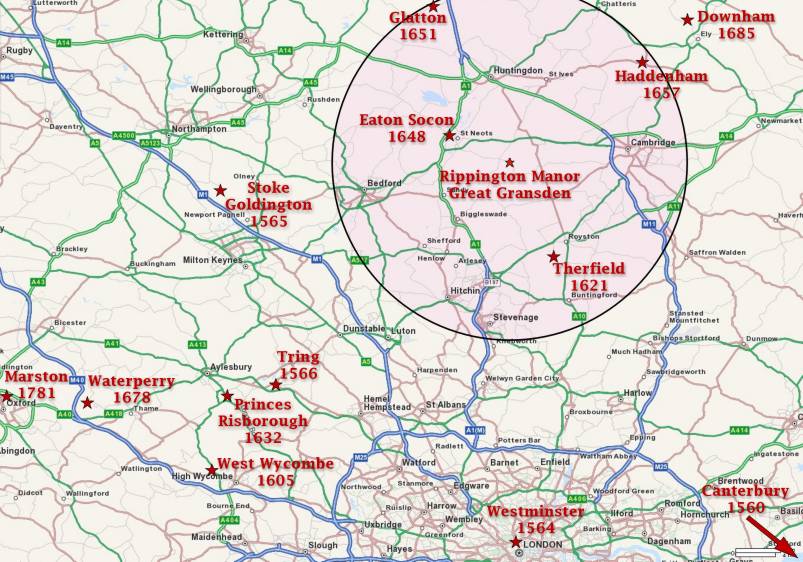
|
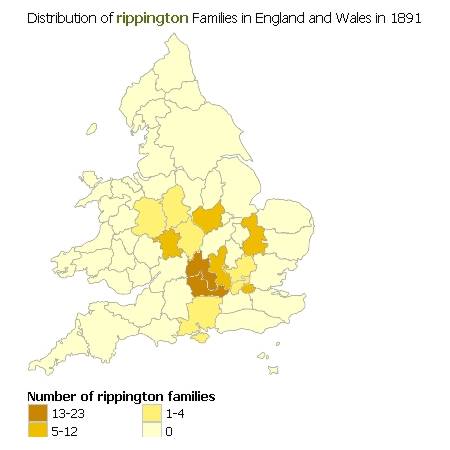
|
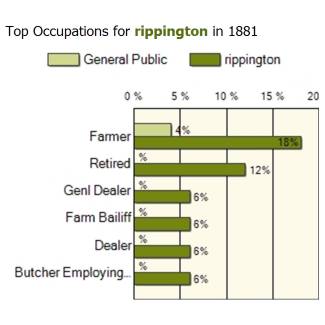
|
'Rippington Family Origins'
- It can be seen from historical details that the
name has its primary origins as an association of someone from Repton
in Derbyshire, which was anciently called
Repington.
- Referring to the maps above though it is very clear
though that specifically the Rippington
family is a 'Home-Counties' phenomenon
and the historically documented Repington family
is quite different, being titled, appearing in Burke's Peerage
(click on the Repington Family Crest below for more details), historically owners of Amington
Hall in Tamworth and has much closer origins with Repton.
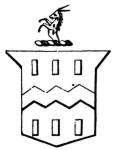
- Repington Family Crest
- Recent research has found documentary evidence
that indicates a very distinctive reason for the differentiation
between Repington and Rippington
... although both names have their origins in Repton,
it seems that it was who was using the name that
made the difference in pronunciation and spelling.
It appear that Rippington is derived from the name that the
Latinate monks of Repton
Priory used - as in the Priory of
Rypyngdon and the Parysshe Church of Rypyngdon ... also written as
Rypingdon.

We've got Henry VIII to thank for the following highly detailed
evidential record (amongst other similar documents from around the
same time) ... shown on www.british-history.ac.uk
Letters and Papers, Foreign and Domestic, Henry VIII, Volume 21 Part 2: September 1546-January 1547
38. Thomas Thacker. Grant in fee, for 648l. 11s. 8d., of the house and site of the late priory of Rypingdon alias Repton, Derb., with lands (specified) in Repton and Staunton which were kept in the prior's own hands, and certain other lands and woods (names and extents given) in Repton parish.
Referring to the historical origins of Repton,
the vernacular name for the town was based upon the Roman
Repandunum, the Saxon Repandum or Hreopedune and also the Normanesque
Repington
- as in Simon de Repington
(and hence the recorded history of the Repington
family and it's direct association with Repton)
... these are much earlier versions of the town's name than the
Latin Rypyngdon as used by the Priory.
Another document also from the reign of Henry VIII in 1536, also
shown on www.british-history.ac.uk,
clearly explains why we have Rippington
Manor:-
Letters and Papers, Foreign and Domestic, Henry VIII, Volume 14 Part 1: January-July
1539
6. John Yong, the prior, and the convent of Holy Trinity, Rypyngdon, Derb. Licence to alienate the manor of Graundesden Magna and lands in Graundesden Magna, Hardewyke, and Leycotte, Hunts; Sutton Bonyngton, Notts; and Westleyke and Estleyke, Notts; with the advowsons of the churches of Westleyke and Estleyke and lands in Donesthorpe, Derb.; and the advowson of the vicarage of the church of Magna Badowe, Essex; to Sir Fran. Brian, Sir John Porte, Sir Geo. Gresley, and Hen. Audeley, their heirs and assigns for ever. Del. Westm., 4 Jan. Vacated because inrolled on the fifth part of patent roll 29 Hen. VIII. [See Vol. XIII. Pt. I. 190 (7)]. Pat. 30 Hen. VIII. p. 2, m. 2.
Graundesden Magna is of course Great Gransden and this particular
document details the transfer of the Priory's land to Henry Audley et al.
as explained on the Rippington
Manor page.
As detailed in the 1547 document above, Thomas Thacker acquired
the ex-Priory buildings at Repton, and these were subsequently inherited by his son, Gilbert.
Gilbert Thacker, alarmed at the prospect of the re-establishment of the monasteries under Mary Tudor, had the greater part of the Priory demolished, including the magnificent Priory
Church
- “to destroy the nest for fear the birds should nest there
again”.
- What is interesting to investigate is the
chronological progression of both surnames from their medieval
spelling to their modern-day forms.
In Middle English (1154–1470) Y became identical to I - therefore, many words that originally had I were spelled with Y, and
vice-versa. After 1470 Chancery Standard English was used for most official purposes except by the Church, which used Latin.
The chronological charts shown below document the progression of
each surname from Repyngdon to Repington and Rypyngton to Rippington,
although when the latter had previously changed from Rypngdon to
Rypyngton is the most interesting unknown and would clearly answer
the question as to the true familial origin of all Rippingtons.
|
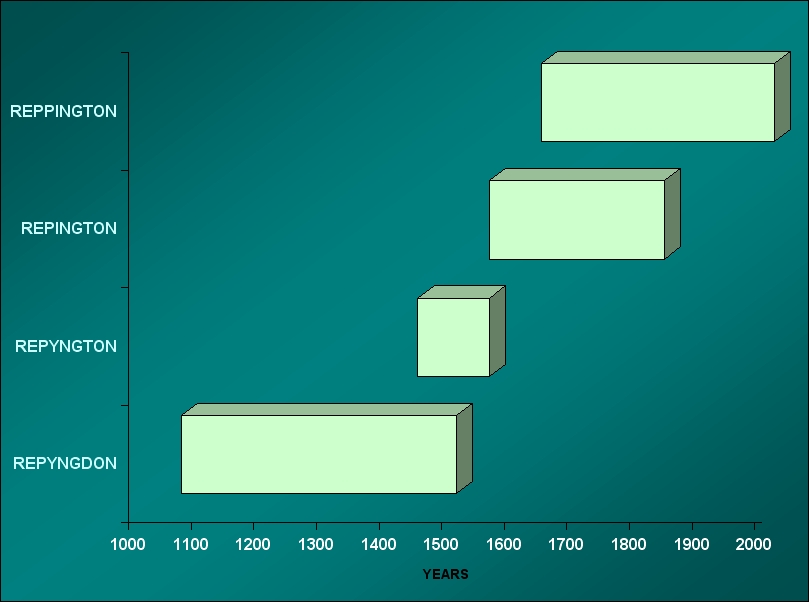
|
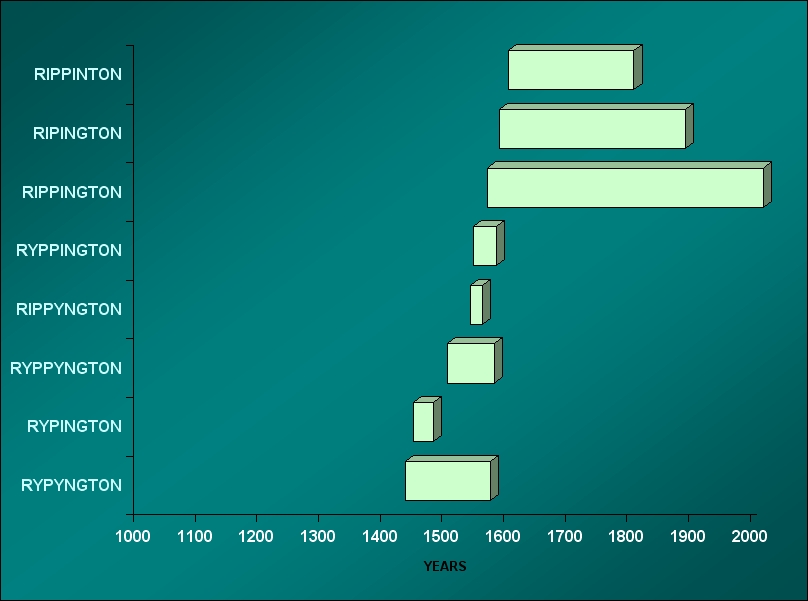
|
- The two charts show the progression of the
surnames over the centuries from their 'Y' laden origins to their
present day forms.
It's interesting to see that both surnames first took on their
modern spellings at almost exactly the same time - Repington in 1557 and Rippington in 1564.
Queen Elizabeth I came on the throne in 1558; so after all the
religious chaos that had ensued during her predecessor Henry
VIII's reign (i.e. the Reformation), it may simply be that for
both families anything that looked like it had a religious
association, particularly anything Catholic or Latin was frowned
upon.
- One clear difference is that the peerage records
allow the tracing of the Repington
surname all the way back to the 11th century, but the earliest
record found so far for a Rypyngton is 1431.
- Considering all these details the question that needed answering is why did it take until 1431 for the Rippingtons
to appear in the records?
|
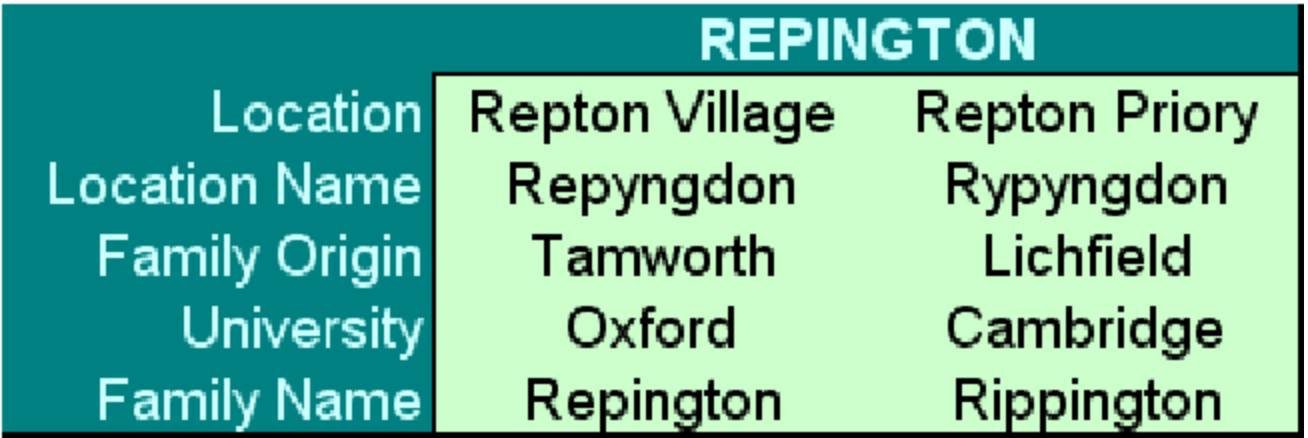
|
- One source of differentiation in the names could have been association
with the priory ... was it a member of the Repington
family that was in some way ecclesiastical? or was it an unrelated
family that had a strong association with the lands around Great
Gransden?
i.e. Rippington
Manor.
- One other possible source of this name differentiation is the
particular university that family members attended:-
All the members of the Repington family from Tamworth going to
university, went to Oxford
- the Alumni Oxonienses
lists entirely Repingtons. Cambridge University's Alumni Cantabrigienses
lists entirely Rippingtons (with a few dual namings in there at
the beginning ... all later copies of these records list the name
as Rippington).
- But more likely it now appears that it was the Lichfield
Repingtons who were the prime instigators of the name change from
Repyngton
to Rypyngton, sometime in the early 1400s - it was their close
association with London and the home counties, when it appears that
maybe their Midlands accent made Repyngton sound like Rypyngton
... or possibly it could have been that Rypyngton sounded
more 'Urban' and modern at that time.
- More than just the name change though, mounting evidence is now
being found that it was this actual family that are the actual
progenitors for all the Rippington families; as quite a number of
them have now been found to have had direct associations with
locations within a few miles of where the Chiltern Rippingtons
are to be found in Tring just a few decades later in 1548, and
also the City of London Rippingtons
in 1472.
- William Repyngton, Armigeri
(now suspected to be the William Rypyngton recorded in 1431)
had land associations in Buckinghamshire with the MP of
Buckinghamshire; John Hammeden of Kymbel (Kymbel being an
early name for Great Kimble).
He was also associated with Sir Robert Whittingham - a very
prominent MP and London merchant.
- Thomas Repyngton,
William's grandson, made the move from Lichfield to London
in 1498.
- Ambrose Rippington / Repyngton
moved from Lichfield to Buckinghamshire in around 1474.
- Ralph Repington was
born in Drayton Beauchamp (2 miles from Tring) in 1522.
- William Repyngton
owned Wadlowes Manor in Toddington (15 miles from Tring) in
1564.
|
- The names Repington and Rippington have frequently been interposed though - two significant early members of the
Repington
family were Dean Ralph Repyngdon - a religious contemporary of John Wycliffe (1328-1384) and
Bishop Philip Repyngdon who followed in Wycliffe's footsteps (1345-1424) ...
more than one archive document
refers to these two as Ralph Rippington and Philip
Rippington.
- Another complication in this name differentiation
has been that just before the beginning of the 19th century
(approx. 1780) many Repingtons
changed their name to Rippington - Parish records in areas that
had previously only shown Repington (or Reppington) baptisms
suddenly start showing Rippingtons .... and in some instances even
within the same parental family.
It's well documented that the peerage Repington
family were well known and were getting quite a reputation for
themselves - one gentleman of their family being referred to as a
'Wag' in the popular press at the time. Maybe the association with
the Repington name wasn't
always favorable(?).
This situation didn't always persist though, as there's one
familial example where they changed their name back to Repington
in later generations. But we still do now have instances where
living Rippington descendants have Repington
origins and these are detailed below.
- Getting back to the Rippington
distribution map above it seems that
there are various clusters of this family and with this in
mind let's try and understand where all the various members came from.
- Firstly with my personal family root from Princes
Risborough - these seem to be part of a group that I'll refer
jointly as the Chiltern Rippingtons (from the Chiltern
hills in Buckinghamshire).
The Chiltern Rippingtons came out from West Wycombe in 1605 and
it's looking highly likely that they can be linked backed to
earlier (1566) families in Tring, Hertfordshire.
- An early branch of the Chiltern Rippingtons
moved a few miles west and formed one of the more wealthy family
groups - the Oxford Rippingtons, which in turn produced one
of the most well documented families - the Marston Rippingtons.
This family group settled in Marston (now a suburb of Oxford) from around
1801 and became major Farmer Landowners in the area, even having a
couple of roads named after them - Rippington Drive (Oxford OX3)
and Rippington Court in Sutton Wick, Drayton. At the same time
other members of these families also owned a variety of butcher
shops in the west end of London.
- A group of Rippingtons appeared in
London in the early 16th century. Although originally this had
been thought to be just one group, further research has shown that
there were two distinct main clusters - one in the City of
London and another in Westminster.
The reason why these familial locations are now considered to be separate
is that at this time in history Westminster was outside the City
of London; being connected to it only by a country road.
The family in Westminster appear in the parish records for St. Margaret's Church, which
stands between Westminster Abbey and the then Westminster Palace -
a highly salubrious location. Westminster Palace later became the
Houses of Parliament, and St. Margaret's Church has commonly been
called 'the parish church of the House of Commons'.
- One branch of the family had been a little difficult to
explain - the Historical Kent Rippingtons - the earliest parish
records shows an 'Elizabeth Rippington' being married in Canterbury in 1560,
and not long after this that there are numerous Rippington births
in the area (obviously there must have also been male ancestors around
here at the same time).
It's now been shown that all these families (most likely) came from the
City of London Rippingtons - Elizabeth
looks like being Elsabeth Ryppyngton
and Roger Rippington has been documented working for Sir William Herbert, the
1st Earl of Pembroke in London and then moving to the Earl's other
house in Faversham, Kent.
- Another major group of the family that has persisted to the
present day is the Sussex Rippingtons - appearing at West
Hoathly in about 1639.
In a sense the later families in this group ought not be called
Rippingtons, as Ann Maria Rippington from Sedlescombe
didn't marry her son's Father Robert Crisford. It looks
like Robert could have been fairly wealthy, which he seems to have
endowed upon his son John Crisford Rippington. John
traveled the country as a Journeyman Miller, doing very well for
himself and subsequently his descendants moved into wealthy
Knightsbridge. One of these, Sidney Thomas Rippington,
travelled even further and moved to Canada.
Interestingly Sidney was only followed to Canada by one other
early Rippington family member
- John
Walter Rippington, a descendent of the Oxford Rippingtons.
- Obviously these family migrations didn't happen
overnight, they mostly occurred over numerous generations as
families slowly moved from village to village ... although
obviously on occasions it did take just one individual to up-roots
and move to a completely new area.
William Christopher Rippington (b. 1852) was one such individual in my own
branch of the family who did just that - leaving behind his
impoverished family in Hertfordshire to find his fortune in the
horse-racing industry in Newmarket (shame it never really
happened).
Reasons for these family relocations were, as today, very various -
workers looking for employment, farmers looking for more land,
young men and women meeting partners from other areas, escaping family feuds
... and many more reasons.

- Repington Family Crest
- coloured version
(The heraldic societies don't differentiate between
Repington & Rippington)
- Heraldic Armorial & Crest description — of ancient origin:
ARMS.—Quarterly of four. 1 and 4. Gules, a fess indented ermine between six billets argent.
2. Gules, a saltire or. 3.
Gules, a crescent or.
CREST.—A demi antelope salient gules, billellée argent, attired,
Tufted and unguled or.
- The family motto is Virtus Propter Se - "Virtue for its own sake".
The dictionaries give propter as "on accout of", or "by reason of", "for the sake of"
or "as its own reward" are a little more idiomatic in English.
Also, virtus very often denotes a kind of manly excellence rather than "virtue" per se, so
"valour" is likely to be a better meaning.
Therefore drifting away from the strict Latin translation to a more modern version you could also say
"Valour as its own reward".
Life isn't about waiting for the storm to pass - It's about learning to dance in the
rain - Virtus Propter Se
- For those interested, the Rippingtons that came
from Willoughby-Waterless in Leicestershire,
should really be Repingtons.
All the children born in this area around and before 1760 were
christened Repington (or Reppington), descended from the
Warwickshire Repington families (most likely from William Repington
born in 1699 in Kingsbury, Tamworth) ... those in the next
generation around 1780 were variously christened Reppington or
Rippington ... and the 1800s families curiously became all
Rippingtons(?).
So that the family of Benjamin Rippington (b. 1803), later to be
found in Littlethorpe in Leicestershire, are not related to any of
the other Rippingtons on this family tree.
- The same confusing situation applies to one other
individual and his supposed siblings
- John Rippington (b. 1828), originally these children were thought to be true
Rippingtons, born in Ireland to an emigrant Rippington father ....
but detailed subsequent research now suggests that they're much
more likely to be descended from the Repington
family ... with John even being shown as John Reppington on one
document associated with him.
- So in conclusion, this is the story so far - there are about
125 living Rippingtons on the electoral roll in this country (that includes any partners with the name Rippington) ...
plus about 20 or so children and around another 20 overseas.
I've found only around 700 people, ever, who've been born with the Rippington surname.
In fact the vast majority of all living Rippingtons are descended from
just one individual
- a Thomas
Rippington born in 1587 ... his existence is quite real -
as you'll see we've even got a copy of his Will
.... have a look at the transcription,
it makes interesting reading.
'I'm not expecting to find many more names to add to the family
tree now! ... and I really must thank Martin Conlon for all his help with this
research ...'
I made that comment at the beginning of 2011 - subsequently I've
found out quite a bit more about the scope of this family and also
the many descendants of those married and now with new surnames,
who are obviously very proud to be associated with the Rippington
name.
So I must also extend my most sincere thanks to many in the family
and their friends who have and are still contacting me with more
details:-
- Brian Rippington
- Shaun Rippington
- Roger Rippington
- Chelsie Rippington
- Dave Rippington
- Paul Rippington (Bournemouth)
- Paul and Carolyn Rippington (Canada)
- Di Vaughan
- Alison Jeffery
- Diana Jensen
- Robert Kibblewhite
- Colin Wells (www.bloodhound-ancestry.co.uk)
- Elizabeth Brown
- Carole Cronk
- Maurice Edgington
- Sean Billingham
- Jane Ward
- Noel & Avril Deam
- Phil Silvey-Reardon
- John Nixey
- Alexander Macfarlane
- Michael Taylor
- Vicky Land-Roberts
- Ros Dunning
- Roger Lee
- Vic Styles
- Stephen Dawe-Kuta
- Karen Marchant
- Stephen Evans
- Roy Charleau
- Margaret Havens
- Ron & Carol Reppington
- Catherine Fekete
- Neil Calver
(apologies if I've forgotten anyone)
- Thanks must also be extended to Polly Holmes à Court
for all her research into the Repington
family history, including family portraits shown on this web site.

Polly
Holmes à Court's Family Web Site ... for all Repingtons
- This page will be updated as more is discovered
about the Rippington family - watch this space ...............
|







